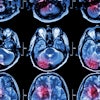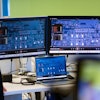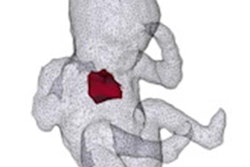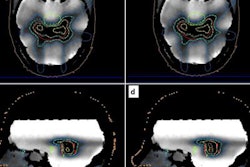
At the recent European Society for Radiotherapy and Oncology (ESTRO) meeting in Milan, a debate examined the skills that medical physicists will require in 10 years' time and asked how training for medical physicists specializing in radiation oncology should develop over the next decade. Five expert speakers presented their thoughts -- and then let the audience decide.
First up, Daniela Thorwarth, PhD, from University Hospital Tübingen made the case that imaging knowledge will be the most important for future medical physicists.
She began by looking at the current radiotherapy training regime for medical physicists in Europe. This includes areas such as fundamental radiation biology, basic radiation protection, exposure effects, and how to deal with accidental exposure. There are also special courses covering, for example, clinical dosimetry or treatment planning. None of these, however, involve imaging.
 The debate speakers (left to right): Daniela Thorwarth, PhD; Ludvig Muren, PhD; Ben Heijmen, PhD; Julian Malicki, PhD; and Giovanna Gagliardi, PhD.
The debate speakers (left to right): Daniela Thorwarth, PhD; Ludvig Muren, PhD; Ben Heijmen, PhD; Julian Malicki, PhD; and Giovanna Gagliardi, PhD.But imaging plays an integral role in all areas of radiotherapy, Thorwarth emphasized. CT is used for treatment planning, dose calculation, and target delineation; images are used for patient positioning, tumor staging, response monitoring, functional characterization, plan adaptation, and proton range verification; the list goes on.
"Imaging already has [a] place in clinical practice," she told delegates. "We need to know how to handle these images properly." And in the future, medical physicists need to be ready to incorporate even more imaging into their working days. "I believe that in 10 years, every patient will receive personalized, online-adaptive, functional image-guided, biologically individualized radiotherapy."
And the future has already started, Thorwarth added, citing the emergence of MRI-guided radiotherapy, which enables daily online guidance. Quantitative imaging, using PET/MR imaging, for example, will enable further personalization of radiotherapy dose prescriptions. This will require additional training and "dedicated QA procedures that may take us out of our comfort zone," she noted.
"To be ready for the future of radiation oncology, we need to train medical physicists to become experts in imaging for radiotherapy," she concluded.
Modeling masterclass
The second speaker was Ludvig Muren, PhD, from Aarhus University, who proposed that what medical physicists will really need is training in mathematical modeling. He pointed out that predictive models form the very basis of radiotherapy, namely the radiation dose-response curves, which were generated from radiobiological modeling. "This is an underexplored interdisciplinary area," he said.
Muren explained that medical physicists have a natural talent for identifying, describing, and solving problems, by building mathematical models and fitting complex data to these models. But they may not necessarily be as skilled at understanding the limitations of model assumptions when working with real-life data. Citing his experience as a journal editor, he noted that basic statistics knowledge is one of the most common problems in submitted research papers.
Moreover, trends in radiobiological modeling are changing and increasing in complexity as new data types are available as model inputs. For instance, future models for tumor control and normal tissue effects may account for inter- and intrafraction variations and spatial effects or incorporate time-dependent end point definitions. "I think this is a very interesting area for medical physics research," he said.
Another factor is the introduction of "big data," which aims to make all outcome data available. While existing models are mostly based on clinical trial data, with some 97% of patients treated outside trials, big data could provide a major opportunity. There are considerable challenges, such as standardization and data accessibility, for example, but Muren predicts that these can be solved.
"Medical physicists should strengthen their basic medical statistics knowledge and learn how to apply and validate increasingly complex radiobiological models," he concluded.
Computational skills
In a similar vein, Ben Heijmen, PhD, from Erasmus University Medical Center argued that medical physicists should receive training in broad computational skills. "Computation is the future of our field," he said.
In 10 years, Heijmen predicted, physicists will need the expertise to deal with areas such as workflow automation, computer optimization, artificial intelligence, and machine learning, as well as advanced statistical modeling and image processing. "I don't think this is needed only for predictive modeling, computational skills have more broad applications," he noted.
One example is the use of deep-learning algorithms for automated image delineation, an emerging application that could save clinicians time during treatment planning. "The ability to automate in a reliable way will have a big impact," said Heijmen. Elsewhere, statistical modeling could be used to verify treatment plans, and virtual SPECT/CT scans could be generated for functional avoidance-based planning. "Complex computation is responsible for major breakthroughs and will increasingly do so," he added.
Another example is beam calibration, one of the principal responsibilities of a medical physicist. "We have to do this in a more clever, faster, automated way," said Heijmen. "We are good at computational methods, and if we get more training, it'll be much easier and more fun."
He rounded off his talk by sharing the topics on offer at the forthcoming 3rd ESTRO Physics workshop. These include computational methods for target volume definition, data fusion for decision-support systems, and implementation of artificial intelligence techniques. "If you don't believe me, believe them," he told the audience. "Computation is where it will go."
Taking charge
Next up, Julian Malicki, PhD, from the Greater Poland Cancer Centre suggested that management and leadership skills will be most essential for future medical physicists. "I believe that this is something that physicists need to acquire because they want a better position for their group in the healthcare system," he explained.
As a leader, Malicki noted, one can influence the direction that others follow, the field that gets the most resources, and, ultimately, the discipline that develops the fastest. As such, it is important to be a leader or at least to have a leader from within your own group, he pointed out.
He described how some people naturally want to be leaders, are skilled and well trained, and become a success. Others come to leadership via hard work and competency. "We should, as a group of physicists, actively seek this opportunity to be leaders," he said. Possible roles include head of a radiotherapy department, head of an entire cancer institute, or even a university dean. Such roles are not usually held by medical physicists, but why not, Malicki asked.
Malicki concluded by emphasizing the importance of having a physicist in a leadership position. A leader can allocate money and manpower and make the life of a medical physics group easier, he said. Crucially, leaders can also prevent a decline of the position of physicists within the healthcare system. And to enable this, it's vital that management and leadership competences are included in the curriculum for future training of medical physicists.
Back to basics
The final speaker was Giovanna Gagliardi, PhD, from the Karolinska Institute in Stockholm. Gagliardi aimed to persuade the audience that future training must simply include more basic physics skills or, equivalently, must reinforce physics knowledge. "We have a responsibility in training the next generation," she said.
She listed some of the techniques currently deployed in clinical departments. These include imaging modalities such as CT, MR, PET/CT, and on-board imaging devices; plus treatment systems, including CyberKnife and tomotherapy, brachytherapy, and proton and heavy ion systems. Tasks today include basic dosimetry, physics of radiation interactions with matter, and creating treatment planning algorithms, to name just a few.
Future requirements will include calculating the passage of charged particles in a magnetic field for MR-linac treatments, physics with kilovoltage photons used in animal irradiations, mixed modalities, and more. "In 2019, there is an enormous quantity of heavy technology that requires basic physics knowledge," Gagliardi explained. "And the requirement of physics knowledge is getting larger."
Medical physicists are increasingly tasked with delivering radiotherapy that is safe, high quality, justified, optimized, state of the art, and individualized. "We need to know physics because we need to know what to do," she said.
Gagliardi cited an example from the past -- the introduction of stereotactic body radiotherapy -- which needed a large quantity of physics knowledge. Today, the increasing proliferation of proton facilities requires "major education to learn the required physics." Looking to the future, she cited GaToroid, a nonrotating hadron therapy gantry under development at the European Organization for Nuclear Research (CERN). "Physics is very good at inventing new solutions and applying them," she pointed out. "These sorts of ideas can be important for the future of radiotherapy."
"Training in more basic physics is not about cutting-edge skills," she concluded. "It is the understanding and application of well-established physics. This is what the content of future education courses should be."
The audience decides ...
In an ensuing discussion, some delegates pointed out that medical physicists can't be all things to all people. For example, mathematicians and other physics groups will be looking at big data, and it may be better to collaborate with them. One audience member emphasized that medical physicists are already trained to be scientists. "We probably need to know something about all of these things, and need to know what we don't know and where to find that from," he said.
The ultimate winner was decided by a show-of-hands vote. And the winner? The ESTRO delegates decided that basic physics skills are the most important training requirements for future medical physicists.
Tami Freeman is the medical and biophysics editor for Physics World.
© IOP Publishing Limited. Republished with permission from Physics World, a website that helps scientists working in academic and industrial research stay up to date with the latest breakthroughs in physics and interdisciplinary science.



















